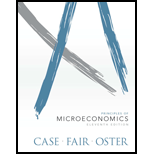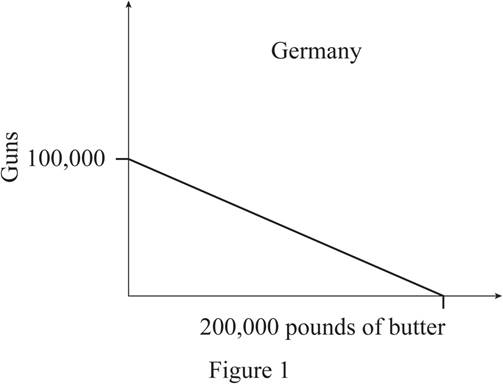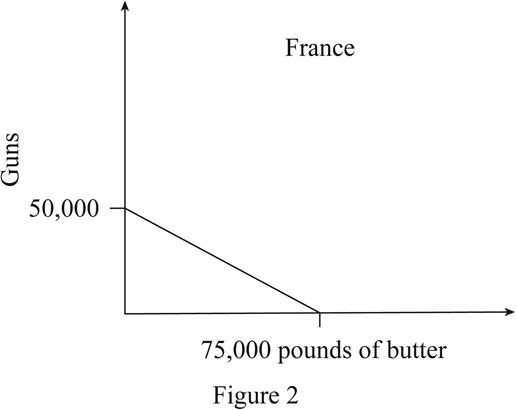
(a)
The
(a)
Explanation of Solution
Figure-1 shows the PPC curve for the country G in the absence of trade.

In Figure-1, the y-axis shows the quantity of guns and the x-axis shows the quantity of butter. The given line shows the PPC of these two products in the absence of trade.
Figure-2 shows the PPC curve for the country F in the absence of trade.

In Figure-2, the y-axis shows the quantity of guns and the x-axis shows the quantity of butter. The given line shows the PPC of these two products in the absence of trade.
Production possibility curve: PPC represents the maximum output combinations of the two commodities that can produce at the given inputs in the economy.
(b)
Identify the role of transportation costs in trade.
(b)
Explanation of Solution
In country G, the value of
Comparative advantage: The comparative advantage theory states that specialization in a particular commodity based on the opportunity cost and free trading will benefit the trading partners.
(c)
Identify the role of the trade agreement in the exchange process.
(c)
Explanation of Solution
In country G, the value of opportunity cost of a gun is 2 pounds of butter and in country F, the opportunity cost of gun is 1.5 pounds of butter. Therefore, the trade will be beneficial to both the countries if they agree to exchange 1.75 pounds of butter per gun.
Trade agreement: The trade agreement is an agreement introduced by the trading partners about the rates of tariff, taxes, guarantees, and trade treaty
Want to see more full solutions like this?

 Principles of Economics (12th Edition)EconomicsISBN:9780134078779Author:Karl E. Case, Ray C. Fair, Sharon E. OsterPublisher:PEARSON
Principles of Economics (12th Edition)EconomicsISBN:9780134078779Author:Karl E. Case, Ray C. Fair, Sharon E. OsterPublisher:PEARSON Engineering Economy (17th Edition)EconomicsISBN:9780134870069Author:William G. Sullivan, Elin M. Wicks, C. Patrick KoellingPublisher:PEARSON
Engineering Economy (17th Edition)EconomicsISBN:9780134870069Author:William G. Sullivan, Elin M. Wicks, C. Patrick KoellingPublisher:PEARSON Principles of Economics (MindTap Course List)EconomicsISBN:9781305585126Author:N. Gregory MankiwPublisher:Cengage Learning
Principles of Economics (MindTap Course List)EconomicsISBN:9781305585126Author:N. Gregory MankiwPublisher:Cengage Learning Managerial Economics: A Problem Solving ApproachEconomicsISBN:9781337106665Author:Luke M. Froeb, Brian T. McCann, Michael R. Ward, Mike ShorPublisher:Cengage Learning
Managerial Economics: A Problem Solving ApproachEconomicsISBN:9781337106665Author:Luke M. Froeb, Brian T. McCann, Michael R. Ward, Mike ShorPublisher:Cengage Learning Managerial Economics & Business Strategy (Mcgraw-...EconomicsISBN:9781259290619Author:Michael Baye, Jeff PrincePublisher:McGraw-Hill Education
Managerial Economics & Business Strategy (Mcgraw-...EconomicsISBN:9781259290619Author:Michael Baye, Jeff PrincePublisher:McGraw-Hill Education





